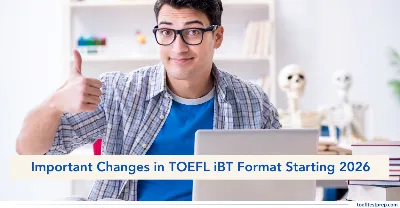TOEFL iBT® Reading Tips: How to Read Complex & Long Sentences

"TOEFL Reading passages frequently include complex sentences that combine multiple ideas, several clauses, advanced vocabulary, and sophisticated grammatical structures."
Complex and long sentences in TOEFL reading passages typically contain multiple ideas, advanced vocabulary, and sophisticated grammatical structures.
Mastering these reading sentences can help you score better on the TOEFL Reading iBT section. So, let's explore how to read complex and long sentences in TOEFL Reading section with these effective strategies that will help you navigate such sentences with confidence.
Looking to boost your TOEFL score?
Sharpen your skills with our TOEFL Practice Tests , designed by experts!
TOEFL Reading Tips: How to Read Complex & Long Sentences
Here are some expert tips that will help you understand complex and long sentences more easily and quickly, improving your overall reading skills for the TOEFL test:
1. Identify the Main Clause
Find the core subject and verb of the sentence. That is usually the central idea.
- Explanation: Each sentence presents a main idea. Identify the main subject (who or what a sentence is about ) and the main verb (what's going on).
- Example: Sentence: 'The early settlers, who managed to build thriving communities despite facing numerous hardships, arrived with limited resources.'
- Main clause: 'The early settlers managed to build thriving communities.'
2. Break Down the Sentence
Mentally divide the sentence into smaller parts.
- Explanation: A long sentence is easier if you break it up into parts. Read each part separately and then put them all together.
- Example: Although at first rather skeptical, the scientific community came to take an amazingly ground-shaking theory for truth based on many years of long observations.
- Breakdown:
Though skeptical at first,
the scientific community,
after reviewing the extensive data collected over several years,
eventually accepted the groundbreaking theory.
3. Use Punctuation as a Guide
Watch out for commas, semicolons, and other punctuation marks.
- Explanation: Punctuation often separates ideas or indicates relationships between parts of a sentence.
- Example: The experiment had three phases: preparation, which took two weeks; execution, lasting a month; and analysis, requiring several months of careful study." Here, the colons and semicolons separate the main parts of the experiment.
Check out - Is 25 a Good TOEFL iBT® Reading Score?
4. Spot Signal Words
Look for words that indicate relationships between ideas.
- Explanation: Words like ‘however,’ ‘because,’ or ‘although’ show how different parts of the sentence relate to each other.
- Example: ‘Although promising, the initial results led the researchers to run further tests in order to be certain of the reliability of their findings.’
- Signal words: ‘Although’ (contrast), because (reason)
5. Practice Active Reading
Interact with the text by asking yourself questions.
- Explanation: As you read, ask questions about what each part means and how it connects to the whole sentence.
- Example: Sentence: ‘The Renaissance was such an age of cultural and artistic revival that began in Italy during the 14th century and spread to the rest of Europe.’
- Questions to ask:
What is Renaissance?
When did it start?
Where did it start?
How did this progress?
6. Use Context Clues
Infer the meaning of unknown words with surrounding information.
- Explanation: When you come across some unknown word in a sentence, look at the words and ideas leading up to and following it for a guess of its meaning.
- Example: ‘The hypothesis presented by the scientist was considered contentious, and the scientist had to engage in heated debates with her peers.’
- Context clue: It's easy to bring up a sense of ‘contentious’ having something to do with ‘sparking heated debates,’ so it must mean controversial or likely to cause disagreement.
Check out - Time Management Tips for TOEFL Reading Section
7. Read in Phrases
Group words together rather than reading one at a time.
- Explanation: Reading groups of words at a time allows one to better grasp the meaning and accelerate the process./
- Example: Rather than: The | rapid | industrialization | of | the | 19th | century | led | to | significant | social | and | economic | changes.
- Read as: The rapid industrialization | of the 19th century | led to | significant social and economic changes.
8. Summarize in Your Own Words
Simply restate the main idea of complex sentences using simpler wording.
- Explanation: After reading a difficult sentence, try to explain its core meaning to yourself using simpler language.
- Example: The proliferation of digital technologies has, in turn, made revolutionizing paradigms of communication possible, whereby suddenly one is able to connect with another out there worldwide.
- Summary: New digital tech has changed how we communicate; keys to easy, instant connectivity worldwide.
9. Expand Your Vocabulary
Learn and study often words that are usually employed in most academic texts.
- Explanation: You will know more words to understand difficult sentences without getting stuck on unknown terms.
- Examples: Learning words such as "albeit," "paradigm," "empirical," "caveat," and "anomaly," which come up inhere in many academic writings.
Struggling with reading comprehension?
Check out our TOEFL Reading Practice Tests to boost your skills and ace the exam!
10. Practice with Various Text Types
Expose yourself to diverse forms of academic writing regularly.
- Explanation: Practice reading a wide range of texts, similar to the TOEFL passages in content, to see different styles and sentence structures.
- Example: See below: Read articles in scientific journals, books of history, literature reviews, and academic blogs to be exposed to a wide range of sentence structures and vocabulary.
By consistently practicing and applying these tips, you'll improve your ability to understand complex and long sentences in TOEFL Reading passages, which can significantly improve your overall TOEFL score. Happy learning!
Also Read:
Featured Articles

TOEFL Format Undergoing Significant Changes in January 2026
The TOEFL iBT format is changing in January 2026 with a smarter structure and easier scoring. Here’s everything you need to know to stay ahead.
August 06, 2025
Minimum TOEFL Score Requirement for South Korea Student Visa
Understand the TOEFL requirement for a South Korea student visa and English-taught programs, and prepare your application for success.
September 14, 2025
Minimum TOEFL Score for Study Visa in Poland
Understand TOEFL score requirements for securing a Poland student visa and joining top universities offering English-taught programs.
September 14, 2025
TOEFL Requirements for Animation & VFX Programs Abroad
Discover TOEFL score requirements for studying Animation and VFX abroad, and learn how to meet them for top creative universities.
September 14, 2025